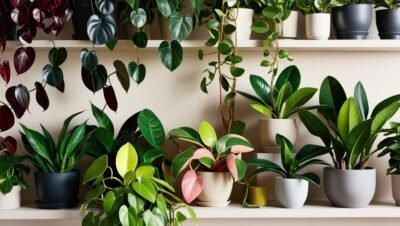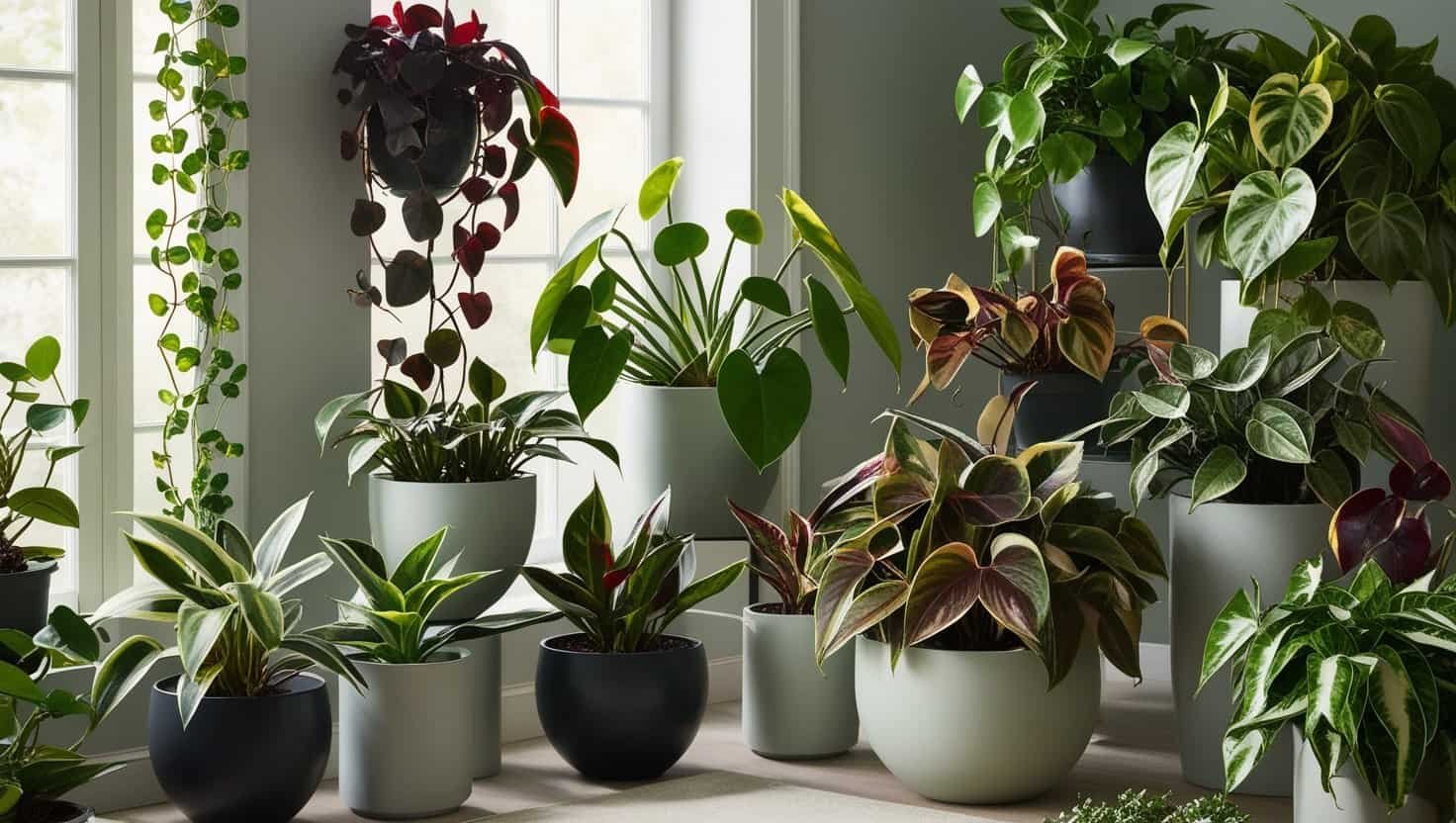Philodendron cultivars are enjoy by many houseplant owners for their attractive foliage and low-maintenance nature. Their leaves come in various shapes and colors that can brighten up any room. Whether in bright light by the window or low light across the house, these plants adapt well. Some varieties may climb while others remain bushy. For those interested in learning about philodendron’s easy care and unique styles, keep reading to discover more about these popular indoor greens. Dive into the different cultivar options and what each variety needs to thrive on your watch.
Key Takeaway
- Philodendron cultivars are low-maintenance and adjust well to various light levels.
- Their leaves come in different shapes and hues, brightening up rooms.
- Favorite varieties comprise the ‘Rojo Congo’ known for dazzling red leaves and ‘White Knight’ admired for white-streaked foliage.
What Are Philodendron Cultivars?
Philodendron cultivars refer to special types within the Philodendron family. Plant breeders have developed these to highlight unique leaf shapes, colors, and growth habits. There are two main groups – vining and upright.
Vining cultivars like ‘Heartleaf’ trail beautifully. Their long stems can drape down hanging pots and shelves. Upright types such as ‘Xanadu’ grow more like small shrubs. This makes them good for filling space.
Philodendrons come in all kinds of sizes and forms. This helps them fit any room nicely. They do well with little light or plenty of light. Because of these traits, philodendrons add green appeal to many homes. Whether climbing or bushy is preferred, there is a philodendron for anyone wanting plant life indoors. Their versatility earns them popularity with plant parents.
Popular Philodendron Cultivars
Many philodendron types are favorites among plant parents. Each has its own special features making them appealing for different reasons.
The ‘Rojo Congo’ stands out with dark green leaves with a dramatic red backside. Collectors love its contrasting colors and graceful look.
The ‘White Knight’ is known for its unusual white-spotted leaves. Finding one makes plant lovers happy since they’re not common.
The ‘Burle Marx’ is popular for its distinct lobed leaves. Their texture adds interest wherever they’re placed. It brings a tropical feel indoors.
These are just a few of the many philodendron kinds. All provide their own beauty growing inside. Whether new to plants or experienced, there’s a philodendron for any style.
Care Requirements for Philodendron Cultivars
Caring for philodendron plants is rather easy. This makes them good for many plant parents. Here are some simple care tips to keep these green beauties thriving:
Lighting: Philodendrons do well in bright, indirect sunlight. Solid green types adjust to low light but variegated kinds like ‘Brasil’ need more light to keep their bright colors. Near a window with filtered rays works well.
Watering: It’s important to water philodendrons correctly. Water when the top inch of soil is dry. Over-water can cause root rot, a big problem. Drain holes in pots help prevent this [1].
Humidity: As tropicals, philodendrons enjoy moisture. Put a pebble tray with water under the pot. Misting leaves now and then also works. This keeps air humid enough.
Follow these routines and philodendrons will prosper indoors. With regular care of their needs, their leaves become lush plants to brighten living spaces.
The Benefits of Growing Philodendrons Indoors
Growing philodendrons indoors offers many benefits making them a favorite choice for home decor.
Clean air: Philodendrons help purify air by absorbing toxins as they release oxygen. This makes the indoor space healthier to live in.
Low work: Philodendrons don’t take much work. Their simple care fits people with little time. They also do fine in low or bright light.
Looking nice: With unique leaf shapes and bright colors, philodendrons add appeal anywhere. They attract attention alone or blend in nicely.
For these reasons, philodendrons improve places well. If wanting better air or just to enjoy plant beauty, they deliver on both. Their advantages make them excellent picks for inside.
Unique Features of Philodendron Cultivars

Philodendrons are popular with plant lovers due to their special traits.
Leaf colors: Philodendron leaves come in many shades. Some are deep green while others show off bright lime green or even cool pink colors. This lets plant parents mix and match for nice displays.
Leaf shapes: Philodendron leaves vary a lot in form too. Certain types have lobed leaves with indentations while others are smooth shiny ovals [2]. This adds visual interest wherever planted.
Growing styles: Climbing kinds can grow long vines across shelves. Others stay in bush shapes reaching a few feet tall. So they fit well in smaller or larger spaces.
These qualities make philodendrons beautiful and flexible. Their looks suit any home décor style. They bring nature inside no matter the room.
Common Issues with Philodendron Cultivars
While philodendrons receive little fuss, they can still face some issues. Knowing about these helps keep them healthy.
Root rot: This happens when soil stays too wet for long. Roots don’t like wet feet. Let the top soil dry between waterings and use pots with holes on the bottom.
Pests: Bugs like spider mites and aphids can bug philodendrons. Check leaves regularly for tiny invaders. Treat quickly if any appear to stop damage.
Light needs: Some philodendrons prefer certain light. Solid green ones do fine in low light but variegated plants may lose colors without enough rays. Place each kind where it wants light.
By recognizing possible problems, plant parents can prevent sick philodendrons. Taking steps protects their philodendron friends against rot, bugs and light troubles.
Propagation of Philodendron Cultivars
Growing more philodendrons through propagation is easy. Plant parents have fun doing it too.
Stem cuttings: Take a stem section with leaves and put it in water or soil. In warmth and humidity, roots will sprout.
Division: For big philodendrons, split the root ball carefully. This makes new plants while keeping the old one going too.
Propagation grows more green buddies. Plant moms/dads also share with others by doing this. It grows collections in a practical way. The process can bring enjoyment to people who love plants.
FAQ
What size can I expect from popular philodendron cultivars?
Most philodendron cultivars like Dark Lord and White Knight can grow three feet to six feet tall indoors. The mature size varies – Hope Selloum can spread several feet wide with deeply lobed leaves up to ten inches long. Vining types like Silver Sword can extend several feet long when given proper support.
Which philodendron varieties are best for beginners?
Easy care varieties like Green Congo and Burle Marx are a great choice for new plant parents. These cultivars tolerate lower light conditions and are considered best selling philodendrons for indoor plant collections. Rojo Congo and Lemon Lime philodendrons are also forgiving options.
How do I identify different philodendron leaf patterns?
Leaf veins are key identifiers – White Wizard shows striking white veins, while Thai Sunrise features bright green to lime green variations. Dark green elephant ear shapes are common in the plant family. Some varieties like Ring of Fire display bright pink new growth, while Silver Leaf types have metallic sheens.
What growing conditions do philodendrons need?
Most philodendrons prefer bright light but not direct sun. Plants grow best in moist soil that’s well-draining. Maintain humidity using a pebble tray. Costa Rica natives, they thrive in warm indoor environments. Black Gold and White Knight varieties may need slightly higher humidity.
How do I care for rare philodendron varieties?
Premium varieties like Dark Lord and Silver Sword need attentive care. Keep leaf stems clean and watch for root rot. Most prefer plant food during growing season. Red bristle growth is normal on some varieties. The care level varies, but maintaining moist well-draining soil is crucial for glossy green foliage.
How can I identify healthy philodendrons at a plant shop?
Look for varieties with glossy green or deep green foliage. For vining types like Burle Marx, inspect leaf stems for firmness. Healthy specimens should have vibrant green leaves – whether light green or glossy dark varieties. Avoid plants showing signs of root rot or wilting.
What’s special about the Philodendron ‘Lemon Lime’?
This fast growing cultivar features bright lime green foliage that adds pop to indoor spaces. It’s a vining type that can grow several inches long and wide. The lobed leaves maintain their vibrant color even in lower light conditions, making it a popular choice among collectors.
What are some standout philodendron varieties for collectors?
The White Wizard and Green Congo are highly sought after for their distinctive looks. The White Knight shows striking white patches, while Dark Lord features deep burgundy tones. Another favorite is Black Gold, known for its glossy dark foliage and compact growth.
How big do statement philodendron varieties get?
Hope Selloum can reach impressive sizes, growing several feet tall and wide with elephant ear shaped leaves. Getty Images often showcase these mature specimens (image credit: various botanical gardens). These plants grow best with adequate space to spread their lobed leaves.
Conclusion
Philodendrons are great indoor plants needing little work. Their eye-catching leaves come in many styles and colors. Philodendrons suit any space, whether dangling or standing tall. Both new and experienced plant moms/dads feel joy growing philodendrons. They deliver beauty, flexibility, and convenience. Philodendrons happily make spaces greener without much bother. Their easy nature brings plant life within everyone’s reach.
References
- https://www.realsimple.com/home-organizing/gardening/indoor/philodendron-varieties
- https://leafyplace.com/philodendron-types/
Related Articles
- https://knowngarden.com/philodendron-not-doing-well/
- https://knowngarden.com/philodendron-for-low-light/
- https://knowngarden.com/upright-philodendron-types/

